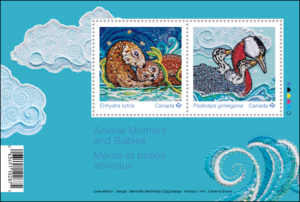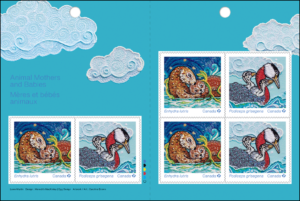Issue date: April 18, 2023
[day of release press release follows the Technical Specifications box.]
Click here to see a surprising FDC for this issue.
From Details magazine:
Issued in the lead-up to Earth Day and Mother’s Day, these stamps depicting the tender relationship between two animal mothers and their babies are a perfect marriage of 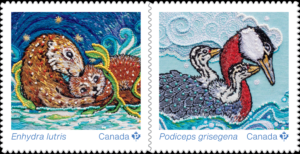 science and art.
science and art.
Halifax designer Meredith MacKinlay and Temagami Anishinaabe artist Caroline Brown collaborated on the concept for the evocative stamp images, which Brown created by combining new and traditional techniques of embroidery and beadwork. “Fabric-based crafts have that feeling of homeyness and familial love,” explains MacKinlay. “Embroidery is so textural, it seemed an ideal way to show the fur of the sea otter and feathers of the red-necked grebe.”
Sole caregivers, mother sea otters float on their backs to feed, groom and cradle their young. The species, once hunted for its luxurious fur, was extirpated from British Columbia but has made a gradual comeback since being reintroduced. Red-necked grebes share responsibility for incubating their eggs and feeding the chicks, which ride on their parents’ backs after hatching. The two species face many threats, including oil spills and other human disturbances.
For Brown, an avid stamp collector as a child and whose First Nations heritage has 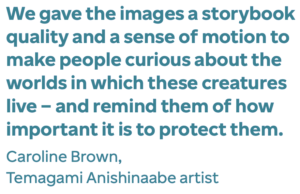 fostered a strong connection with nature, the project was a labour of love. “We worked with wildlife experts to make sure the animals were rendered accurately but also wanted to show the emotional connection between mother and baby,” she says. “We gave the images a storybook quality and a sense of motion to make people curious about the worlds in which these creatures live – and remind them of how important it is to protect them.”
fostered a strong connection with nature, the project was a labour of love. “We worked with wildlife experts to make sure the animals were rendered accurately but also wanted to show the emotional connection between mother and baby,” she says. “We gave the images a storybook quality and a sense of motion to make people curious about the worlds in which these creatures live – and remind them of how important it is to protect them.”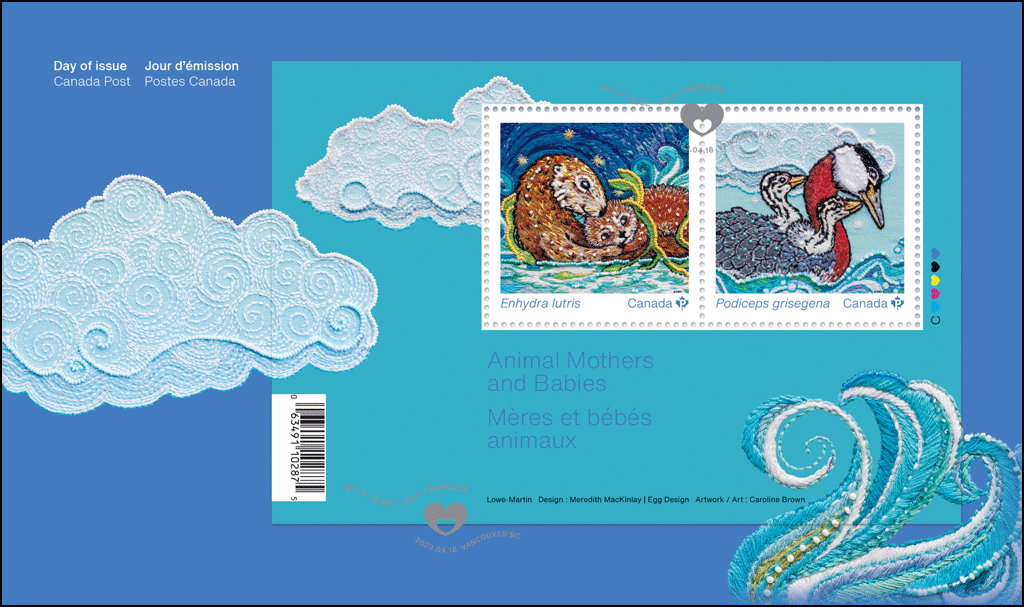 The original artwork crafted for the stamps took several months to create. “The whole philosophy of beadwork is to think about the message you’re trying to convey while you’re doing it,” explains Brown. “You need to have a positive mindset and let it evolve naturally.”
The original artwork crafted for the stamps took several months to create. “The whole philosophy of beadwork is to think about the message you’re trying to convey while you’re doing it,” explains Brown. “You need to have a positive mindset and let it evolve naturally.” Updated April 18th:
Updated April 18th:
[press release] [click on any of the pictures for larger versions]
Animal Mothers and Babies stamp set celebrates two wildly devoted caregivers
Sea otters and red-necked grebes serve as protective floating havens for their young
VANCOUVER – Canada Post today issued a new Animal Mothers and Babies stamp set that highlights two special caregivers of the wild – the sea otter and the red-necked grebe.  Native to Canada, both species are known for their incredible devotion to their young, allowing their babies to float on them during the first stage of their lives.
Native to Canada, both species are known for their incredible devotion to their young, allowing their babies to float on them during the first stage of their lives.
Issued ahead of Mother’s Day and during the week of Earth Day, the stamps celebrate the bond between animal mothers and their young while also encouraging positive action on protecting Canada’s wildlife.
Sea otters
Mature female sea otters give birth to a single pup every year for life. Dedicated to their 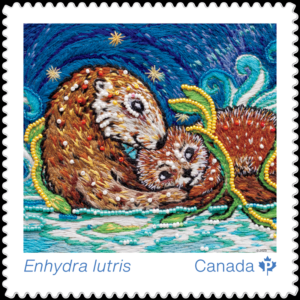 pups for the first six months of their lives, mothers – who are the sole caregivers – float on their backs to feed, groom and cradle their babies. During this time, the pups also learn to forage and swim.
pups for the first six months of their lives, mothers – who are the sole caregivers – float on their backs to feed, groom and cradle their babies. During this time, the pups also learn to forage and swim.
The sea otter was once hunted for its luxurious fur and was eventually extirpated from British Columbia, but the species has made a gradual comeback since it was reintroduced. It continues to face many threats, including oil spills and fishing gear entanglement, and is currently listed as being of special concern in Canada.
Red-necked grebes
Monogamous pairs of red-necked grebes share the parenting duties. The water birds take 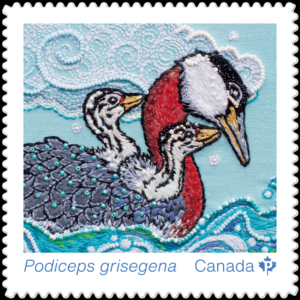 turns incubating their eggs and carrying their chicks, which climb onto their parents’ backs immediately after hatching. The parents continue to transport their chicks on their backs until their offspring are between 10 and 17 days old. At that point, they’re able to swim – though they’re not completely independent until seven to nine weeks when they begin to fly.
turns incubating their eggs and carrying their chicks, which climb onto their parents’ backs immediately after hatching. The parents continue to transport their chicks on their backs until their offspring are between 10 and 17 days old. At that point, they’re able to swim – though they’re not completely independent until seven to nine weeks when they begin to fly.
Found across most of Canada, the red-necked grebes winter off the Pacific and Atlantic coasts. Like sea otters, they face threats such as oil spills, as well as loss of their freshwater nesting habitat from other human disturbances.
About the Stamp
Designer Meredith MacKinlay of Halifax-based Egg Design chose embroidery as the basis
for the design because it evokes the feel of home and family love as well as the texture of fur and feathers. Temagami Anishinaabe artist Caroline Brown created the images on the stamps using a combination of traditional embroidery and beadwork.
Printed by Lowe-Martin, the issue includes a booklet of six Permanent domestic rate stamps, a souvenir sheet of both stamps and an Official First Day Cover. The cancel site is Vancouver, as British Columbia is home to Canada’s only remaining sea otter population.
Stamps and collectibles are available at canadapost.ca and postal outlets across Canada.
[en Francais pour les médias d’information]
Le jeu de timbres sur les Mères et bébés animaux célèbre deux espèces très dévouées
Les loutres de mer et les grèbes jougris servent de refuges flottants pour leur progéniture.
VANCOUVER – Postes Canada a émis aujourd’hui le nouveau jeu de timbres Mères et bébés animaux mettant en vedette deux espèces très protectrices : la loutre de mer et le  grèbe jougris. Originaires du Canada et reconnus pour leur dévouement incroyable envers leurs petits, ces animaux permettent à leurs rejetons de flotter sur eux au tout début de leur vie.
grèbe jougris. Originaires du Canada et reconnus pour leur dévouement incroyable envers leurs petits, ces animaux permettent à leurs rejetons de flotter sur eux au tout début de leur vie.
Émis avant la fête des Mères et pendant la semaine du Jour de la Terre, les timbres célèbrent le lien entre les femelles et leurs petits, tout en encourageant la prise de mesures positives pour protéger la faune du Canada.
Loutres de mer
La femelle loutre donne naissance à un unique loutron par année. Seule à prendre soin de  ses petits, elle flotte sur le dos pour les nourrir, faire leur toilette et les porter pendant les six premiers mois de leur vie. Pendant cette période, les bébés loutres apprennent également à se nourrir et à nager.
ses petits, elle flotte sur le dos pour les nourrir, faire leur toilette et les porter pendant les six premiers mois de leur vie. Pendant cette période, les bébés loutres apprennent également à se nourrir et à nager.
Autrefois chassée pour sa fourrure luxueuse, l’espèce avait disparu de la Colombie-Britannique, mais a fait un retour graduel depuis sa réintroduction. Figurant aujourd’hui sur la liste des espèces préoccupantes au Canada, la loutre de mer continue d’être exposée à de nombreuses menaces, comme les déversements de pétrole et l’enchevêtrement dans les engins de pêche.
Grèbes jougris
Tour à tour, mâles et femelles grèbes jougris, qui sont des oiseaux aquatiques  monogames, couvent leurs œufs et transportent leurs oisillons, qui grimpent sur leur dos immédiatement après la naissance. Ils continuent à transporter leurs bébés jusqu’à ce qu’ils aient entre 10 et 17 jours. À ce moment-là, les jeunes grèbes peuvent nager, bien qu’ils ne soient pas complètement indépendants avant sept à neuf semaines, lorsqu’ils commencent à voler.
monogames, couvent leurs œufs et transportent leurs oisillons, qui grimpent sur leur dos immédiatement après la naissance. Ils continuent à transporter leurs bébés jusqu’à ce qu’ils aient entre 10 et 17 jours. À ce moment-là, les jeunes grèbes peuvent nager, bien qu’ils ne soient pas complètement indépendants avant sept à neuf semaines, lorsqu’ils commencent à voler.
Présents presque partout au Canada, ces oiseaux hivernent au large des côtes du Pacifique et de l’Atlantique. À l’instar des loutres de mer, ils sont exposés à des menaces comme les déversements de pétrole, mais aussi à la perte de leur habitat de nidification en eau douce causée par l’activité humaine.
À propos des timbres
La designer Meredith MacKinlay, de l’agence Egg Design d’Halifax, a choisi la broderie
pour base de la conception, car cette technique dégage une certaine chaleur et une aura d’amour familial, en plus de bien rendre la texture de la fourrure et des plumes des animaux. Caroline Brown, artiste anishinaabe de Temagami, a créé les œuvres des timbres en combinant la broderie et le perlage.
Imprimée par Lowe-Martin, l’émission comprend un carnet de 10 timbres PermanentsMC au tarif du régime intérieur, un bloc-feuillet des deux timbres et un pli Premier Jour officiel. Le lieu d’oblitération est Vancouver, car la Colombie-Britannique abrite la seule population de loutres de mer qui subsiste au Canada.
Les timbres et les articles de collection sont en vente sur postescanada.ca et dans les comptoirs postaux partout au pays.
Updated May 7th:
Going the extra mile for an unofficial-location FDC! VSC contributor “Danforth Guy” serviced this picture postcard in Stephenville, Newfoundland, with the first day date for these stamps: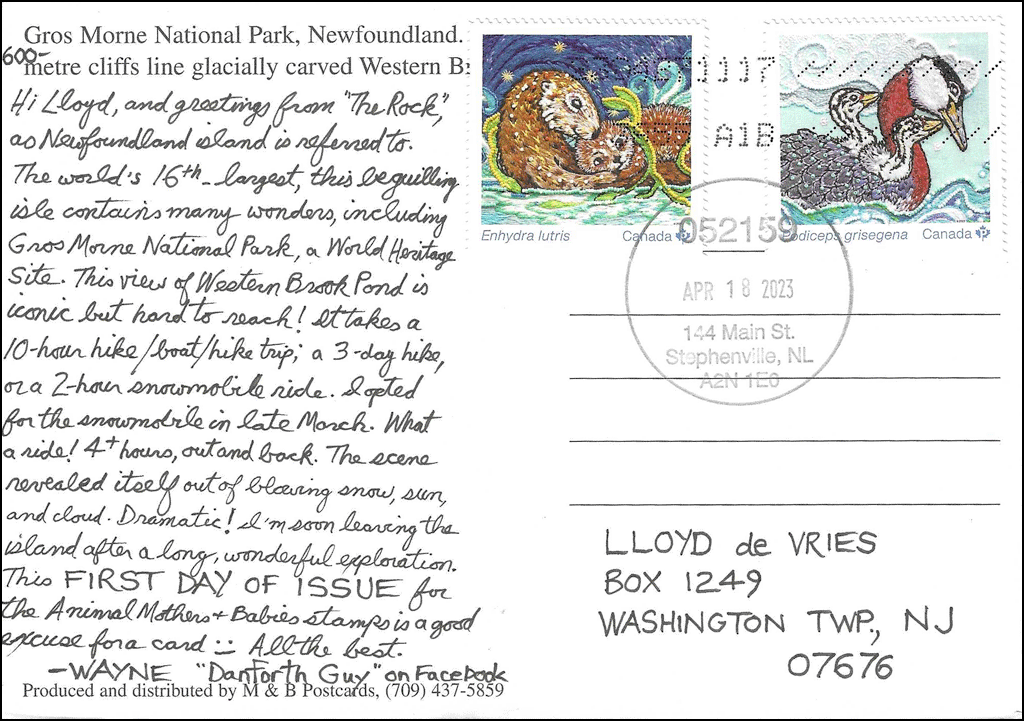 Here’s the front of the card showing this World Heritage Site:
Here’s the front of the card showing this World Heritage Site: 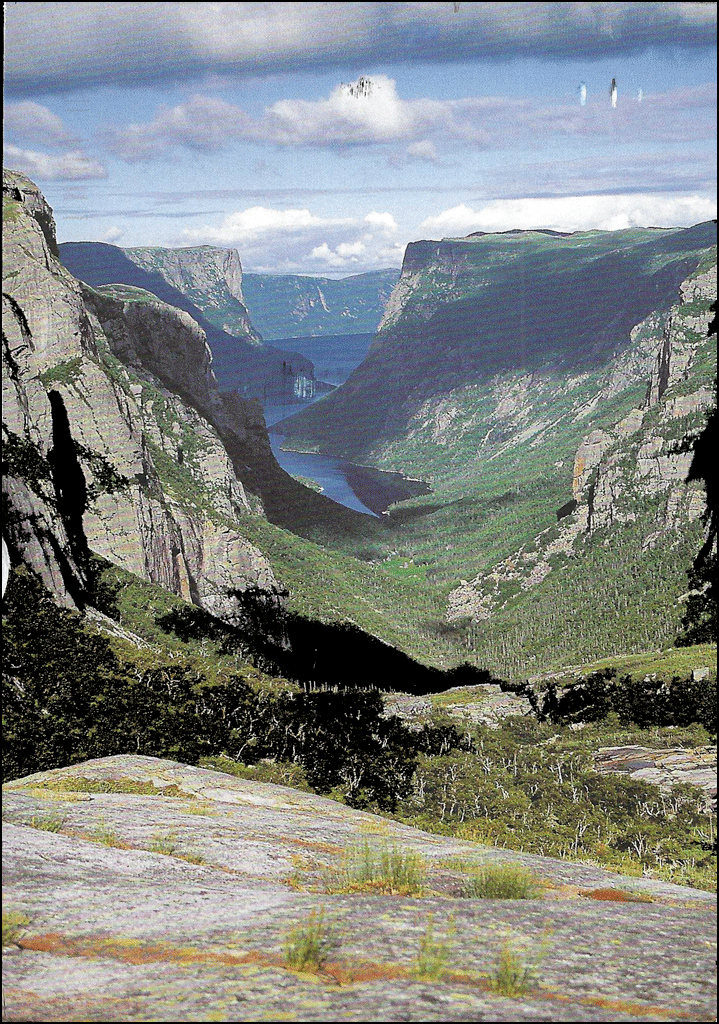 It took Danforth two hours by snowmobile to the park:
It took Danforth two hours by snowmobile to the park: 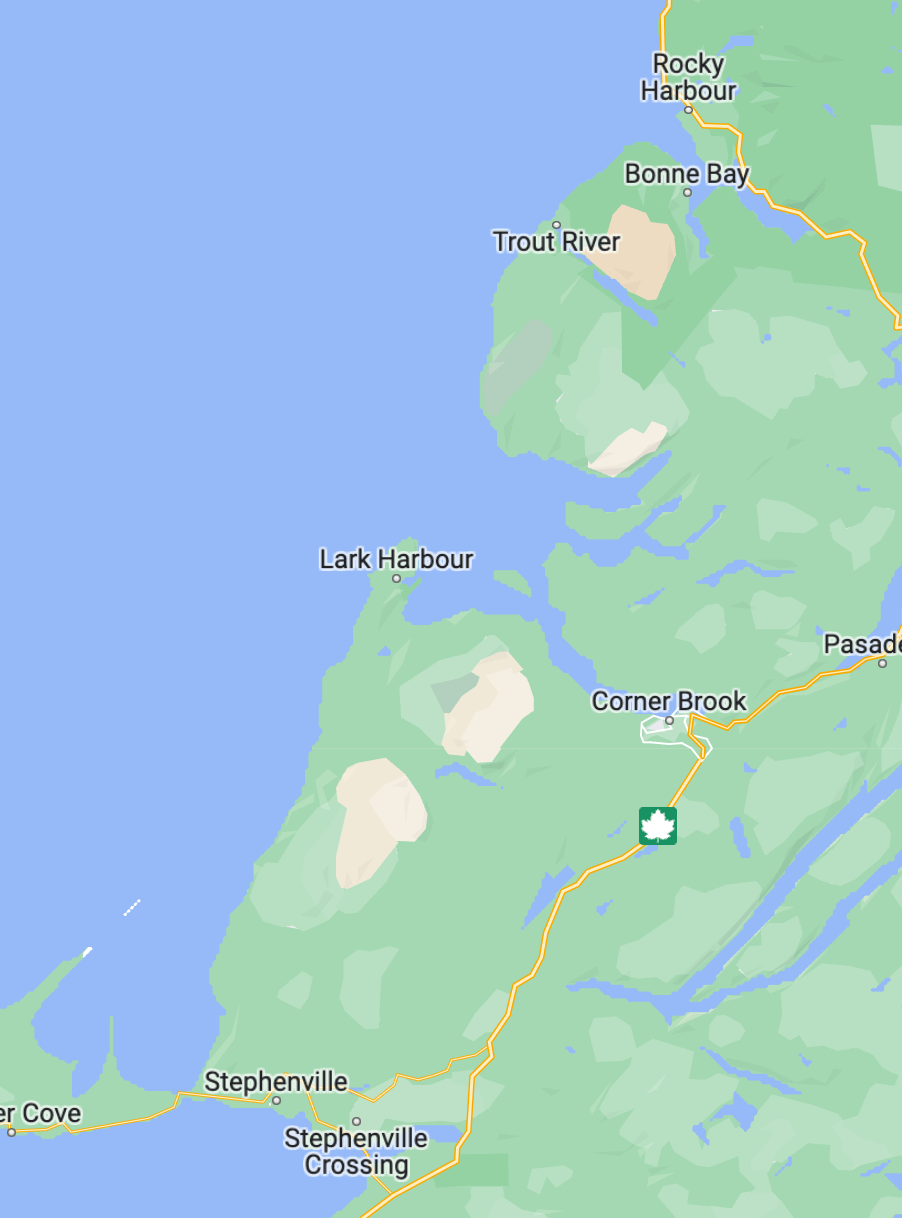 Rocky Harbour at the top of this map is just outside the park, and you’ll find Stephenville at the bottom, about 200 kilometers (120 miles) by road. (Google Maps doesn’t give trip estimates for snowmobiles.) Our intrepid correspondent made the trip in late March, and as you can see in this next map, it’s far enough north that a solid snowpack in late March is not out of the question.
Rocky Harbour at the top of this map is just outside the park, and you’ll find Stephenville at the bottom, about 200 kilometers (120 miles) by road. (Google Maps doesn’t give trip estimates for snowmobiles.) Our intrepid correspondent made the trip in late March, and as you can see in this next map, it’s far enough north that a solid snowpack in late March is not out of the question. 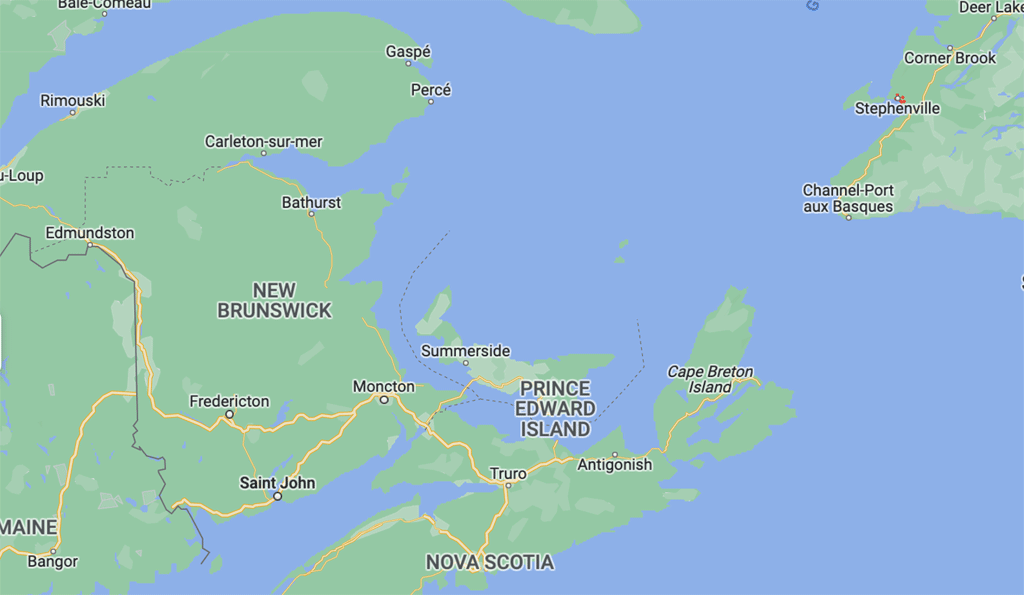 Thanks, “Guy!”
Thanks, “Guy!”

